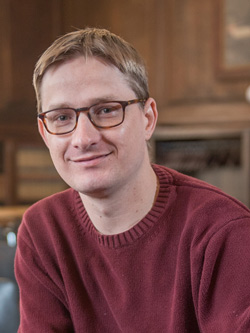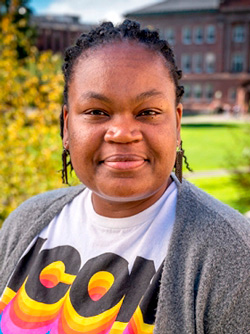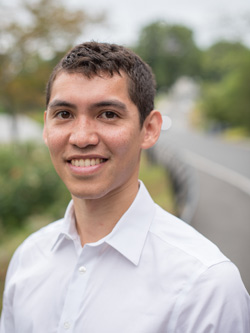‘Grace, Empowerment, Growth’: Insights from the Sherrerd Teaching Award Winners
Campus Life

Published October 26, 2022
Grace, empowerment, growth: These are among the goals that recipients of the 2022 Sherrerd Teaching Awards aim for in their classrooms.
This year’s honorees—Jeffrey Ahlman, associate professor of history; Samuel Ng, assistant professor of Africana studies; and Candice Price, associate professor of mathematics and statistics—are an inspiration to their students and colleagues. Their nominators describe them as role models who are “innovative,” “committed,” “engaging,” “supportive,” and “fun.”
The campus community is invited to a celebration of this year’s award winners on Wednesday, Nov. 9, at 4:30 p.m. in the Campus Center Carroll Room. A reception will follow in the atrium.
Established in 2012, The Kathleen Compton Sherrerd ’54 and John J.F. Sherrerd Prizes for Distinguished Teaching are awarded annually to faculty members who demonstrate the highest levels of enthusiasm and excellence in teaching at Smith.
Here are some insights from this year’s honorees about their work.
Q. What is your philosophy of teaching?
 Jeffrey Ahlman: “I am not sure I have a well-fleshed-out teaching philosophy. Rather, I approach each course with some scaffolding in place so that we hit a few key themes and concepts. The goal is that the students through their interests, questions, and comments will fill in the gaps. In the hope of fostering this environment, I open each class with the question ‘What did you find interesting, confusing, or annoying about the text?’ From their responses, the students begin building what the course is going to be about. In a sense, I guess, the power of structured and semi-structured crowd-sourcing might be my teaching philosophy.”
Jeffrey Ahlman: “I am not sure I have a well-fleshed-out teaching philosophy. Rather, I approach each course with some scaffolding in place so that we hit a few key themes and concepts. The goal is that the students through their interests, questions, and comments will fill in the gaps. In the hope of fostering this environment, I open each class with the question ‘What did you find interesting, confusing, or annoying about the text?’ From their responses, the students begin building what the course is going to be about. In a sense, I guess, the power of structured and semi-structured crowd-sourcing might be my teaching philosophy.”
Samuel Ng: “I view my role as a facilitator, someone who crafts an environment that is conducive to learning, empowerment, and hope. I expect my students to leave my class not only with an appreciation for the content, but also a stronger sense of their own capabilities. In fact, I want the latter to emerge from the former—I want my students to know that they can enjoy reading and digesting difficult theories, teach a class on their own, become an activist, and effect meaningful change in the world around them. The content that we study can get them there because it shows how everyday people accomplish extraordinary things, even when those doings appear small or insignificant.”
Candice Price: “My philosophy of teaching is one of ‘radical grace.’ I want my students to know that I see them as whole people. I want them to know that I understand and acknowledge that we are all coming into this space with different experiences in life, education, and mathematics. I trust my students when they let me know what support they need. I try my best to reflect on every class and find ways that I can be a better ally to my students.”
Q. What is your favorite class assignment?
 Candice Price: “I started doing an end-of-semester art show in some of my courses. Students are asked to create art based on the course to be showcased to their classmates. I got the idea from a friend, and it really allows the students to tap into their creative side and share something they have learned in their own way. The first art show was in the spring of 2021 and since we were all online, everyone was able to invite colleagues and family to the show.”
Candice Price: “I started doing an end-of-semester art show in some of my courses. Students are asked to create art based on the course to be showcased to their classmates. I got the idea from a friend, and it really allows the students to tap into their creative side and share something they have learned in their own way. The first art show was in the spring of 2021 and since we were all online, everyone was able to invite colleagues and family to the show.”
Jeffrey Ahlman: “Coming from a family with little experience navigating the academy, I found (and still do find) such things as applying to graduate school, fellowships, and navigating university bureaucracies overwhelming. In my colloquia, each student will open the semester by writing a formal personal statement addressed to a real institution—graduate or professional school, internship or granting agency—that they might theoretically apply to in the future. The goal is to provide them with an opportunity to explore, in a low-stakes environment, a genre of writing that most of them will have to engage with at some point. The personal statement also gives me insight into an individual student’s interests and backgrounds, which then provide the backdrop for discussions of their final project in the course—a formal research proposal.”
Q. What inspired you to want to be an educator?
 Samuel Ng: “I had a wonderful teacher in high school who got me excited about history, which had been my least favorite subject. He not only sparked my interest in the content but showed me how transformative teaching can be. In college, I started seriously considering a career in education. Before heading to graduate school, I taught high school history for a brief period and that’s what really convinced me I wanted to continue being an educator. I loved working with students, and my fellow teachers inspired me every day. They showed me how joyously messy teaching can be. It’s fun, funny, unpredictable, collaborative, and always a work in progress. The challenges are certainly difficult, but the joys—those moments when the class comes together with some kind of new understanding—are fantastic.”
Samuel Ng: “I had a wonderful teacher in high school who got me excited about history, which had been my least favorite subject. He not only sparked my interest in the content but showed me how transformative teaching can be. In college, I started seriously considering a career in education. Before heading to graduate school, I taught high school history for a brief period and that’s what really convinced me I wanted to continue being an educator. I loved working with students, and my fellow teachers inspired me every day. They showed me how joyously messy teaching can be. It’s fun, funny, unpredictable, collaborative, and always a work in progress. The challenges are certainly difficult, but the joys—those moments when the class comes together with some kind of new understanding—are fantastic.”
Q. How do you create a welcoming learning environment?
Samuel Ng: “I deploy and embrace vulnerability. I talk to my students—both in and outside the classroom—about my own intellectual journey and identity. I talk about how I never had a teacher who looked like me, how I have always felt like an outsider within the academy, and how my search for home and persistent questions surrounding my identity ultimately brought me into Black studies. I stress that mistakes and missteps are not only acceptable, but critical for learning. In this way, I view the classroom as a place of play and practice. Students bring a variety of enriching experiences into the classroom but are also on common ground as they engage the material and play together.”
Candice Price: “One thing I have learned is that I have no idea what it is like to be a student at this moment in time. But I don’t need to know exactly what my students’ lives are like in order to trust them and show them grace. I try to make Day One a day where we don’t necessarily focus on content, or go over the syllabus, but a day where we get to know each other. My thought process is always one of, ‘I do. We do. You do’—where we discuss what I will do to support them, what we will do to support each other, and what they will do to support themselves. I believe this helps set the stage for a collaborative and supportive environment.”
Q. What is something you have learned from your Smith students?
Jeffrey Ahlman: “My students taught me how to learn. Somehow, I made it through my undergraduate and graduate career with only a limited sense of what that meant. Even though I probably wouldn’t have admitted it, I largely saw learning as a rote process—a sense of box checking. However, I learned quickly that I couldn’t get away with that in the classroom. As a result, each time I entered the classroom became an opportunity—an opportunity to learn, make mistakes, and slowly become more comfortable with the inherent fallibility of teaching.”